One skill that sets top buyer agents apart is quickly converting warm leads into loyal clients. But how do they do this? A buyer presentation! A strategic buyer presentation is crucial as it helps build a lasting professional relationship. It must include a summary of the buyer’s needs, market overview, property selections, and next steps. In this article, I’ll cover the purpose of a buyer presentation and provide a step-by-step guide to creating one. I’ll also offer buyer presentation template examples and key tips for successful presentations.

What Is a Buyer Presentation?
You’ll need to seal the deal with that prospect once you’ve generated a buyer lead through your real estate prospecting efforts. A buyer presentation is a short, semiformal presentation that lays out the professional relationship between buyer’s agents and leads. It is typically given after the initial conversations with potential buyers. It’s a way to showcase your expertise and marketing strategies, convey clear and realistic expectations, explain the homebuying process, and ask questions.
What to Include in a Real Estate Buyer Presentation
In a real estate buyer presentation, it’s essential to include information that thoroughly showcases your expertise and the available property listings. Some key elements to include are as follows:
- Personal introduction: Provide a brief introduction about yourself, your experience in the real estate industry, and any notable achievements that highlight your expertise and neighborhood knowledge.
- Buyer’s needs: Summarize their wants, needs, and dreams for their new home to show that you’ve listened.
- Buying process overview: Break down the buying process into clear, easy-to-understand steps.
- Market overview: Provide a snapshot of the current market conditions, trends, and what they mean for the buyer.
- Financial overview: Discuss financing options, preapproval, and estimated closing costs to prepare them financially.
- Property selections: Present a curated list of properties that match their criteria, highlighting unique selling points.
- Testimonials: Share stories and testimonials from your past clients to show your track record of success and build trust.
- Next steps: Clearly outline the actions needed to move forward.
Steps for Creating a Buyer Presentation
Crafting an effective buyer presentation involves specific steps. These include researching your audience, tailoring your approach, and following up appropriately. Below is an overview of the essential steps for creating a buyer presentation that grabs attention and delivers results.
Step 1: Pick an Interactive Template
Interactive templates fully immerse your clients in the experience during a real estate buyer presentation. These templates enhance the visual appeal of your presentations and make them more engaging and memorable for your clients. Use a template that allows your buyers to explore stunning property photos, view 3D floor plans, and take a virtual neighborhood tour. These features transform the presentation into an exciting journey rather than a static display.
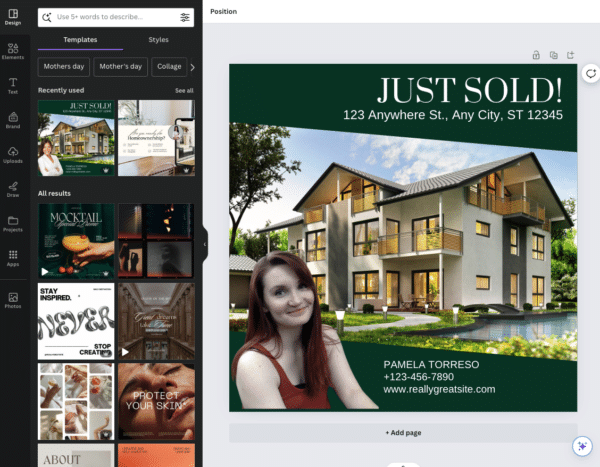
Canva is a popular, easy-to-use, and versatile graphic design tool. It is the preferred design tool for real estate agents who need to quickly create professional marketing materials. Canva offers templates, editing tools, and sharing options for custom property flyers and branded social media posts.
Step 2: Understand & Uncover Your Buyer’s Needs
To understand the buyer’s needs and wants, you must learn about their life and what they like. Instead of asking about basic things like where they want to live and how much money they have, ask them questions via an online form about their current living situation, reasons for moving, previous experiences with buying a home, and what they’re looking for in an agent.
Then, when you meet them, give them a map and ask them to show you where they want to live and where they don’t want to live. They can also write the most important things they want in a home and the things they don’t want. This method personalizes the discussion, making potential buyers active participants in the search process.
Step 3: Clearly Explain the Homebuying Process
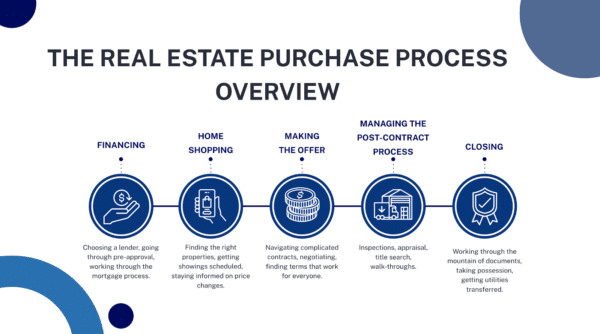
It is essential to guide homebuyers through the intricate homebuying process clearly and concisely. By doing so, you will minimize their anxiety and establish trust.
Here are important steps on the homebuying process timeline:
- Financing: Evaluate financial readiness and credit score.
- Budget: Determine their budget and decide how much your clients can afford to spend on a house.
- Financing options: Research and explore different financing options, such as conventional, FHA, VA, and USDA loans.
- Mortgage: Get preapproval for a mortgage.
- Home search: Selecting properties that meet the buyers’ criteria and arranging viewings.
- Make an offer: Discuss factors like the current market, the home’s value, and how to negotiate effectively.
- Inspections and appraisals: Check that the home is in good condition and worth the investment.
- Closing: Walk them through what to expect at closing, from signing paperwork to receiving the keys.
Step 4: Include a Market Analysis
To help buyers make smart decisions, provide comprehensive market information, including home price trends, property variety in different neighborhoods, average time on the market, and insight into negotiation and purchasing under current market conditions. Ensure you have all the information you need to feel confident about your investment in this market.
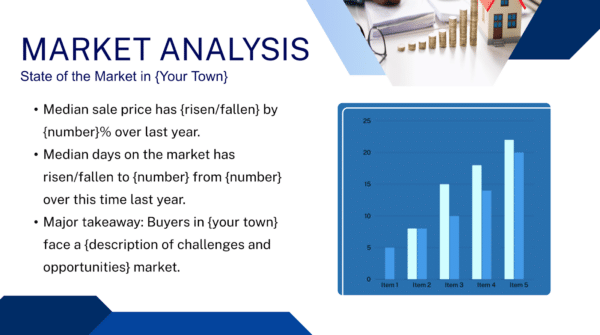
Here is an example script of what you would say to a buyer during the presentation:
“Based on the market analysis, we can see that the average selling price for similar properties in this area has [increased or decreased] by [percentage] over the past year. This indicates a [strong or low] demand for homes in this neighborhood and suggests that now may be a [good or bad] time to make a purchase. Additionally, the [high or low] inventory of similar homes means there is [less or more] competition for buyers, which could work in your favor. Overall, the market analysis indicates [favorable or unfavorable] conditions for purchasing a home in this area.”
Step 5: Showcase Properties

It’s essential to do more than recite the home features when presenting properties. Instead, bring each home to life by creating stories that link the property to the buyer’s lifestyle. To make it engaging and visually appealing, use the following:
- Consider engaging scenarios to make the property features more relatable. For example, you could say, “Imagine hosting Thanksgiving and birthday dinner in this spacious living and dining room,” or “Envision relaxing on the weekend in this bright and tranquil garden patio.” These little narratives can help potential buyers visualize themselves living in the space.
- To appeal to the senses, add vivid sensory descriptions, such as the fireplace’s warmth and the nearby park’s peaceful sounds.
- Use high-resolution images, interactive virtual tours, and authentic testimonials from previous clients to enhance credibility and evoke emotion.
Step 6: Present Different Financing Options
Remember to provide transparent information about the financial aspects of buying a property. This includes explaining the down payments, closing costs, and ongoing expenses like property taxes, insurance, and maintenance. Remember that you are not a mortgage professional, so generalize financing and provide contact information for mortgage professionals.
Step 7: Present Sample Buyer’s Representation Agreement
As you wrap up your presentation, touch on the buyer’s representation agreement. In real estate, things can be full of surprises, and without this agreement, there’s a chance of investing a lot of time in clients only to see them switch to another agent at the eleventh hour. It’s crucial to showcase a sample agreement and guide them through key sections, like exclusive representation, your role as their agent, and how you will receive compensation.
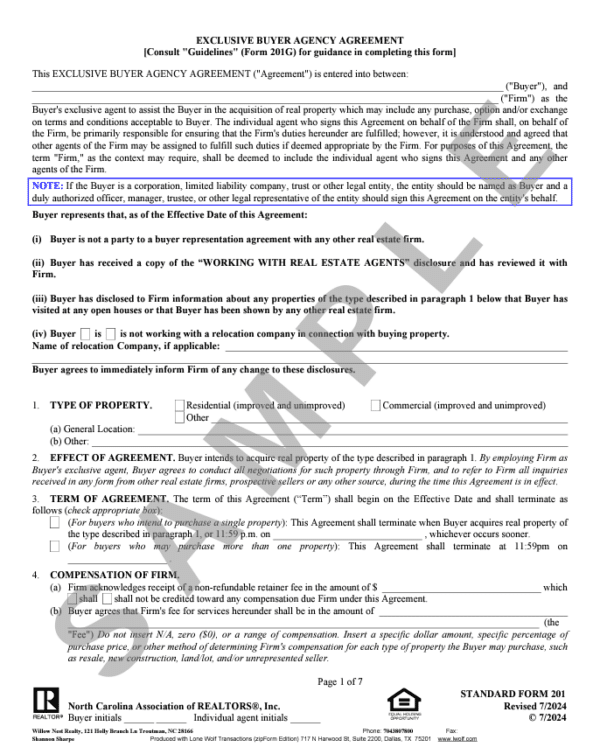
Step 8: Show a Clear Next Step
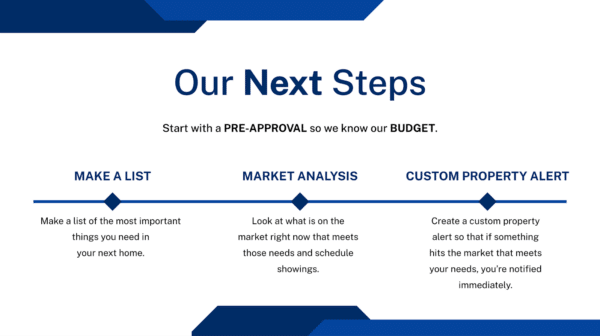
It’s important to end your real estate buyers presentation by clearly outlining the next steps. Instead of just saying “thank you,” let them know what to expect next. This could include setting up property tours or diving into offer strategies. Provide a clear timeline to maintain momentum. Answer any questions and demonstrate that you are prepared to assist them throughout their homebuying journey. This approach keeps things organized and shows your dedication to helping them find the perfect place.
Tips for Delivering a Buyer Presentation
Now that you know how to create a buyer presentation and have a template ready to go, let’s review the tips for delivering your presentation in a way that builds a foundation for a solid buyer-agent relationship.
- Role-play your presentation with another agent. The more you practice, the easier the presentation will be to deliver, even if you have some nerves.
- Deliver your presentation in person (if possible). Avoid giving your presentation virtually because building rapport is much easier in person. Plus, that firm handshake, warm smile, and confident eye contact will go a long way in convincing your leads that you’re the agent for them.
- Use a large monitor or tablet to give your presentation. If you don’t have a conference room with a large monitor, consider pooling together with other agents in your office to buy a big tablet specifically for presentations—better yet, convince your broker to buy you one!
- Break the ice with small talk (but don’t overdo it!). Starting your presentation with a minute or two of small talk will not only break the ice, but it also has the potential to build rapport more quickly than your entire presentation.
- Tell them how long the presentation will take. We think you should keep your part to less than 15 minutes and leave plenty of room for questions.
- Ask specific and open-ended questions. So you can gather information for your profile, build trust, and get them excited about their search. You can ask questions to create an actionable buyer profile during your presentation. Choose three to four questions that best fit your situation and help you build the most knowledge:
- Have you ever worked with a buyer’s agent?
- Why do you want to find a new home, and why now?
- What kind of monthly payment would you be comfortable with?
- How experienced are you with the mortgage process?
- If you had to choose one, would you choose a great location, price, or home?
- Is there a specific school district you want to be in?
- How important is a fast commute to work?
- What is your time frame for finding a home?
- When is the best time and day of the week to reach you, and how do you prefer to communicate?
- Can you paint me a picture of your dream home?
- Don’t ask them to sign an exclusive buyer agreement…yet. Walk them through the agency disclosure agreement and tell them you don’t want them to sign an exclusive agreement until they know you better. Promise to earn their loyalty. When you are ready to ask for the signature, I like a simple, straightforward, “So what do you think? Have I earned your business?”
- Send them a PDF of the presentation. If you really want to wow them, come with buyer agent checklists or write an e-book on the buying process and local market and send it along with your presentation and packet.
- Remember that knowledge = confidence. Walk into your presentation confidently because you have the information and the skills.
Bringing It All Together
Delivering a top-notch, successful buyer’s presentation takes confidence (and a little thoughtfulness), but if you do it well, you can convert those warm buyer leads in as little as 15 minutes. Do you have any real estate buyer presentation templates, buyer presentation scripts, or advice for new agents giving their first buyer presentations? Or maybe a story about a buyer presentation that went sideways? Let us know in the comment section.










